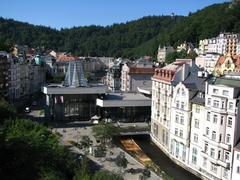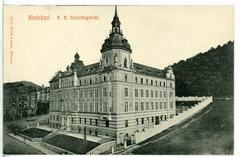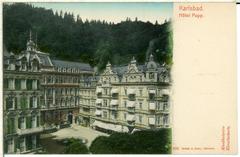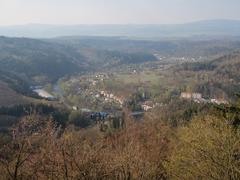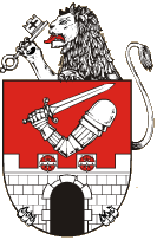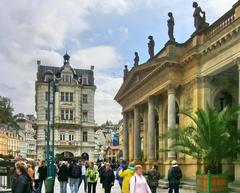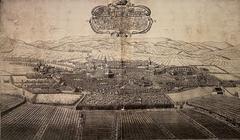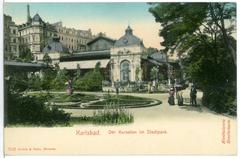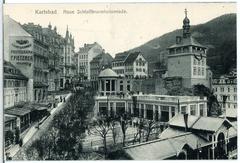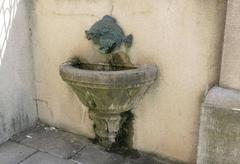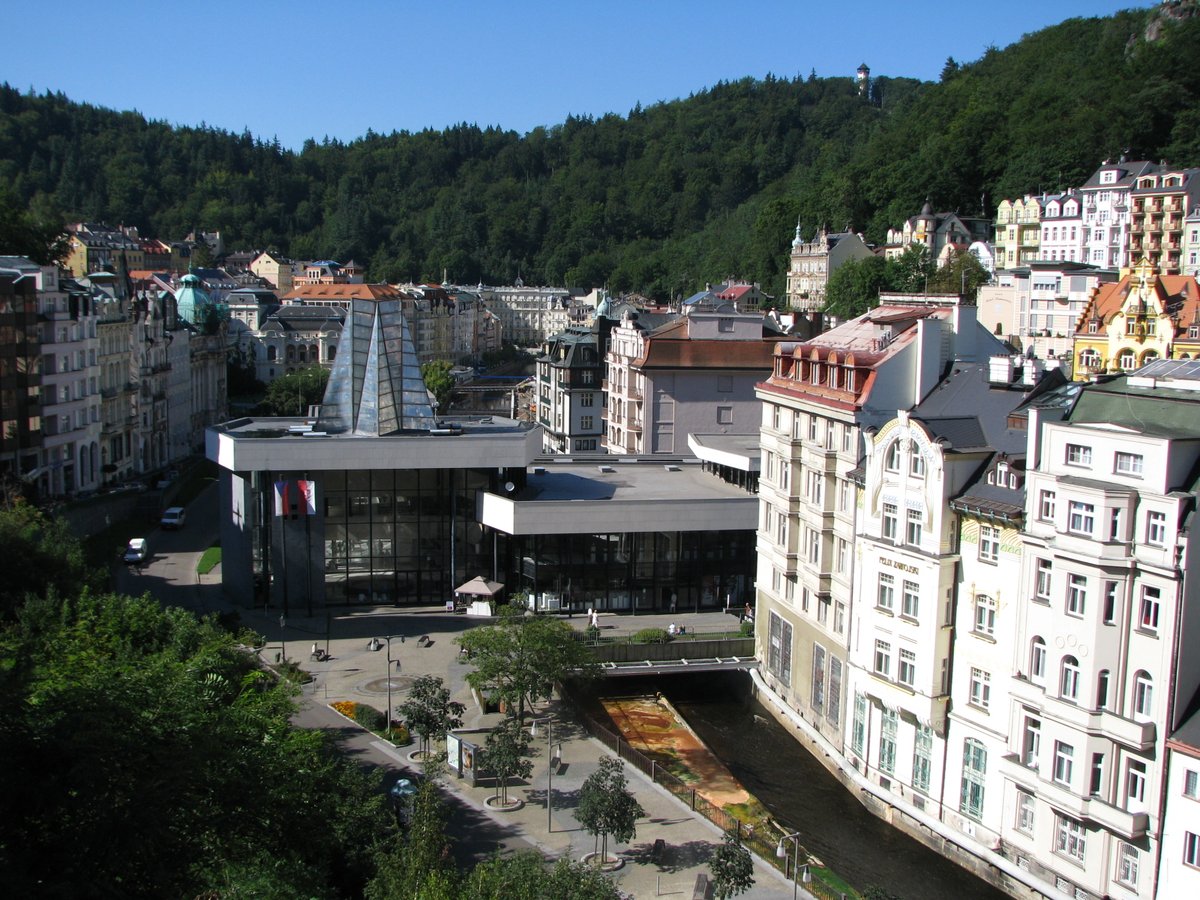
Visiting Vřídelní kolonáda: Hours, Tickets, and Tips
Date: 18/07/2024
Introduction
The Vřídelní kolonáda, also known as the Hot Spring Colonnade, is one of Karlovy Vary’s most iconic landmarks. Located in the heart of this renowned spa town in the Czech Republic, the colonnade is celebrated for its therapeutic hot springs and distinctive modernist architecture. The history of Vřídelní kolonáda dates back to the 16th century when the first wooden structure was built to harness the healing properties of the hot springs, known as Vřídlo. Over the centuries, the colonnade has undergone various transformations, with its current form, designed by architect Jaroslav Otruba, completed in 1975. This guide provides an in-depth look at the rich history, architectural significance, and practical visitor information for Vřídelní kolonáda, ensuring a comprehensive understanding of this cultural gem. For more detailed information, you can refer to the official Karlovy Vary website and the Czech Tourism website.
Table of Contents
- Introduction
- History of Vřídelní kolonáda
- Visiting Information
- Nearby Attractions
- Historical Significance
- Preservation and Restoration
- Cultural Impact
- FAQ
- Conclusion
- References and Further Reading
History of Vřídelní kolonáda
Origins and Early Development
The history of the Vřídelní kolonáda dates back to the 16th century when the first attempts to harness the therapeutic properties of the hot springs were made. The town of Karlovy Vary itself was founded in 1370 by Charles IV, Holy Roman Emperor and King of Bohemia, who was said to have discovered the springs during a hunting expedition. The healing properties of the springs quickly gained fame, attracting visitors from across Europe.
Architectural Evolution
The first colonnade was a simple wooden structure built in the 16th century to provide shelter for visitors who came to drink and bathe in the hot spring waters. Over the centuries, the colonnade underwent several transformations, reflecting the architectural styles and technological advancements of the times. In the 18th century, a more permanent stone structure replaced the wooden colonnade. This new design was influenced by the Baroque style, which was prevalent in Europe at the time. The colonnade continued to evolve, and in the 19th century, it was rebuilt in a neoclassical style, featuring grand columns and ornate decorations.
The Modern Colonnade
The current Vřídelní kolonáda was constructed between 1969 and 1975, designed by Czech architect Jaroslav Otruba. This modernist structure replaced the previous colonnade, which had suffered significant damage during World War II. The new design aimed to blend functionality with aesthetic appeal, providing a spacious and comfortable environment for visitors. The colonnade is characterized by its clean lines, large glass windows, and the use of concrete and steel. It houses the main hot spring, known as Vřídlo, which erupts from a depth of approximately 2,000 meters at a temperature of around 73°C (163°F). The spring can spout water up to 12 meters (39 feet) high, making it a spectacular sight for visitors.
Visiting Information
Visiting Hours
The Vřídelní kolonáda is open daily from 6:00 AM to 6:00 PM. It is recommended to check the official Karlovy Vary website for any updates or changes in visiting hours.
Ticket Prices
Entrance to the Vřídelní kolonáda is free of charge. However, there might be fees for specific guided tours or special events. Detailed information on ticket prices can be found on the Czech Tourism website.
Travel Tips
- Best Time to Visit: The best time to visit the Vřídelní kolonáda is during the spring and summer months when the weather is pleasant, and the town hosts various cultural events.
- Accessibility: The colonnade is wheelchair accessible, and there are facilities available for visitors with disabilities.
- Photography Spots: The colonnade’s modern architecture and the erupting hot spring provide excellent opportunities for photography. Early morning and late afternoon are ideal times for capturing stunning images.
Nearby Attractions
Karlovy Vary is home to numerous other historical sites and attractions worth exploring:
- Mill Colonnade: Another beautiful colonnade in Karlovy Vary, known for its classical design and mineral springs.
- Diana Observation Tower: Offers panoramic views of the town and surrounding countryside.
- Karlovy Vary Museum: Provides insights into the town’s rich history and cultural heritage.
Historical Significance
The Vřídelní kolonáda holds immense historical significance, not only for its architectural evolution but also for its role in the development of Karlovy Vary as a renowned spa town. The hot springs have been a source of healing and rejuvenation for centuries, attracting royalty, nobility, and notable figures from various fields. One of the most famous visitors was Peter the Great, the Russian Tsar, who visited Karlovy Vary in the early 18th century. His visit helped to further popularize the town and its springs among the European elite. The colonnade has also been a site of numerous cultural and social events, contributing to the rich tapestry of Karlovy Vary’s history.
Preservation and Restoration
Over the years, efforts have been made to preserve and restore the Vřídelní kolonáda to ensure its continued use and historical integrity. In the late 20th and early 21st centuries, several restoration projects were undertaken to address structural issues and modernize the facilities. In 2016, a significant restoration project was initiated to repair damage caused by mineral deposits and to enhance the visitor experience. The project included the installation of new lighting, improved accessibility, and the restoration of the colonnade’s original architectural features. These efforts have helped to maintain the colonnade as a vital part of Karlovy Vary’s cultural heritage.
Cultural Impact
The Vřídelní kolonáda is not just a historical monument; it is a living part of the community and a symbol of Karlovy Vary’s identity. The colonnade and its hot springs continue to attract thousands of visitors each year, contributing to the town’s economy and cultural life. The colonnade is also a venue for various cultural events, including concerts, exhibitions, and festivals. These events celebrate the rich history and cultural heritage of Karlovy Vary, providing visitors with a deeper understanding of the town’s significance.
FAQ
- What are the visiting hours for Vřídelní kolonáda? The colonnade is open daily from 6:00 AM to 6:00 PM.
- How much do tickets cost for Vřídelní kolonáda? Entrance is free, but there might be fees for specific guided tours or special events.
- Is the Vřídelní kolonáda accessible? Yes, the colonnade is wheelchair accessible and has facilities for visitors with disabilities.
Conclusion
Visiting Vřídelní kolonáda in Karlovy Vary offers a unique blend of historical significance, architectural marvel, and therapeutic benefits. The colonnade’s modernist design, combined with its rich history dating back to the 16th century, makes it a must-visit destination for anyone exploring the spa town. Beyond its architectural beauty, the colonnade serves as a cultural hub, hosting various events and providing visitors with the opportunity to experience the healing properties of the hot springs. With free admission and a range of nearby attractions to explore, Vřídelní kolonáda is an essential stop for tourists. For more information and to plan your visit, check the official Karlovy Vary website.
References and Further Reading
- Exploring the Vřídelní kolonáda - History, Visiting Hours, and Tickets, 2023 (Karlovy Vary Website)
- Visiting Vřídelní kolonáda - History, Tickets, and Tips for Karlovy Vary’s Iconic Hot Spring Colonnade, 2023 (Czech Tourism)
- Ultimate Guide to Visiting Vřídelní kolonáda in Karlovy Vary - Hours, Tickets, and Tips, 2023 (Karlovy Vary Website)
